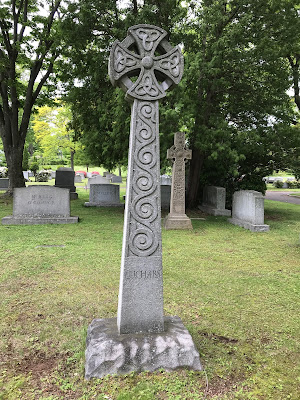A stone for a veteran of the Civil War surfaced at Mount Hebron Cemetery in Montclair, New Jersey.
I wanted to find out more about this soldier. He was in a family plot. Locating him in a census with his family would help to identify him.
John Magai, age 39, born in Austria (probably present-day Slovenia) was living in the Town of Union, Hudson County, New Jersey, in 1900 with his wife, Eliza [Gutberlet or variation], and their many children, including Loid [Lloyd], born in 1893. This fits the Lloyd on the tombstone next to John.
The Town of Union became part of Union City in 1925. Lewis Street became 38th Street.
John may have returned home in Europe a few times. He applied for a passport in New York in 1873, listing his birthdate as May 14, 1843.
An obituary for John Magai appeared in the Jersey Journal on August 18, 1916. He was a veteran who served the 5th New York Cavalry, which does not match the stone.
Next I viewed records at Fold3. John Magai, also known as Johannes Maggai, served in Company E of the 5th Regiment from 1864-1865, then Company I of the 4th Regiment of the New York Cavalry from 1865-1868.
For some reason, the 4th Regiment is on the gravestone, while the 5th Regiment is mentioned in the obituary.

John and Elizabeth probably married as he completed his service. The children were born from 1869-1893. All but Lloyd appeared to have been born in New York.
Lloyd served in the Army in World War I. His application for a headstone can be viewed in color at Ancestry.com.
The stone is inscribed: SERGT JOHN MAGAI CO I 4 U.S. CAV.
I wanted to find out more about this soldier. He was in a family plot. Locating him in a census with his family would help to identify him.
1893-1953
ANN E MAGAI
1902-1986
John Magai, age 39, born in Austria (probably present-day Slovenia) was living in the Town of Union, Hudson County, New Jersey, in 1900 with his wife, Eliza [Gutberlet or variation], and their many children, including Loid [Lloyd], born in 1893. This fits the Lloyd on the tombstone next to John.
The Town of Union became part of Union City in 1925. Lewis Street became 38th Street.
John may have returned home in Europe a few times. He applied for a passport in New York in 1873, listing his birthdate as May 14, 1843.
An obituary for John Magai appeared in the Jersey Journal on August 18, 1916. He was a veteran who served the 5th New York Cavalry, which does not match the stone.
Next I viewed records at Fold3. John Magai, also known as Johannes Maggai, served in Company E of the 5th Regiment from 1864-1865, then Company I of the 4th Regiment of the New York Cavalry from 1865-1868.
For some reason, the 4th Regiment is on the gravestone, while the 5th Regiment is mentioned in the obituary.

Lloyd served in the Army in World War I. His application for a headstone can be viewed in color at Ancestry.com.























